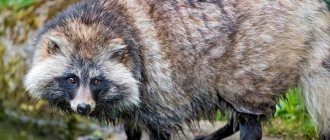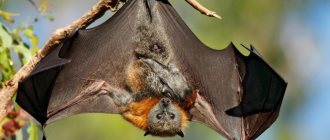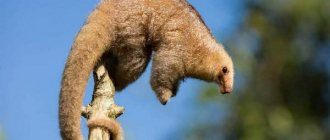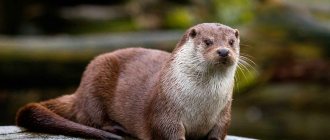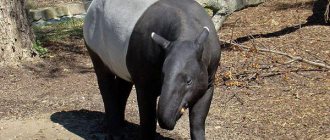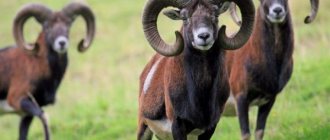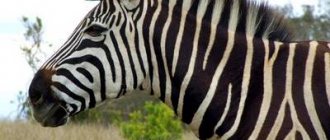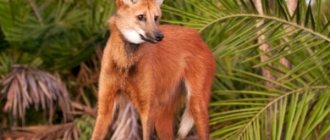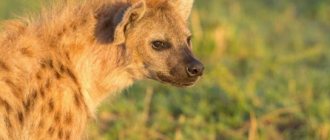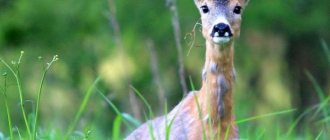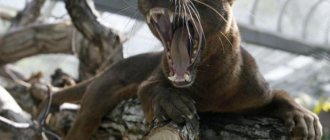Origin of the species and description
Photo: Hyena dog
They belong to the canidae family, a genus of wild dogs. Their lifespan in the wild is on average 8-10 years, but in captivity they can live longer. The wild dog, or otherwise called the “variegated wolf”, due to its unusual coloring, is the second largest representative of wildlife, after wolves. The genus is monotypic. The closest and only ancestral relative is the red wolf.
There are several subspecies of this wild dog in the world:
- the smallest species, the Sahelian subspecies – Chad;
- the most “variegated” subspecies from Mozambique;
- subspecies from West Africa - Togo;
- Western continent - subspecies;
- coastal wolf on the Mozambican coast.
In our century, only the last two subspecies have survived. We'll talk about them in more detail below.
Lifestyle
Wild dogs are active during the daytime. They get their own food and hunt in the morning and evening. They would rather see their prey than smell it, so they need a good view during daylight hours.
The African dog runs well, even over long distances reaching speeds of up to 55 km/h. If there is one short jerk, the speed reaches 65 km/h.
Almost every hunt of these predators ends successfully due to the fact that they do it together with the entire pack, because they need to feed the adult members of the pack and a dozen kids every day. Dogs can walk up to 15-20 kilometers in search of food.
In the natural environment, under normal living conditions, motley animals can live 9-10 years.
Appearance and features
Photo: Wild Dog
Representatives of this family are small in size, smaller than wolves. And they even somewhat resemble domestic dogs and hyenas. Carnivorous predator, with a short mouth of dark color. They have a powerful jaw. This breed boasts the largest molars of any species in this family, as they help chew powerful bones.
Large oval ears promote cooling and clearly detect sound signals. When hunting, pack members are often out of sight of each other. Therefore, maintaining acoustic communication with the help of “huu” sounds, which can be heard at a distance of up to 2 km, is simply necessary for them.
Video: Hyena dog
Long strong legs with four toes. Due to the peculiarity of the structure, the fifth toe on the front paw is lost. The spotted color combines black, white and yellow. The fur on the skin is coarse and sparse, as if it is in constant shedding. But thanks to the variegated color on its fur, it can hunt animals. By knocking down the prey, which seems to have not one, but several dogs running after it. Coloring also helps to recognize each other in the pack.
It seems to us that they are all the same, but for them the “spots” are a distinctive sign. The physique is strong. When hunting, a pack of dogs has to travel vast distances. Body length is up to approximately 1 meter, weight varies (from 16 to 38 kg), at the withers - from 80-146 cm. Males are slightly larger than females.
Color
The hyena dog is characterized by an unusual bright spotted color of short, coarse fur, which is a combination of white, black and brownish-yellow colors. It is hardly possible to find two animals of this species whose fur would have exactly the same color: the pattern of spots is asymmetrical (that is, on the left and right sides it does not match) and is unique for each individual, and only on the head and back of the head is a similar pattern quite often found.
Some wild dogs are predominantly white, while others are black; These colors form the main background, against which darker or lighter spots stand out brightly. There are completely black specimens. The spots are very irregular in shape, also varying in size, and are often distributed throughout the body; white and yellow spots are always bordered with yellow. The muzzle to the eyes is always black, and this color continues in long stripes between the eyes and ears along the crown, back of the head and back. The ears are black, the eyes are brown. The base of the tail is brownish-yellow, the middle is black, and the tip is white and yellow.
Size and weight
The body length of the wild dog is 76-102 cm, but sometimes reaches 1.35-1.5 m in length, of which 35-40 cm is in the tail. Height at the withers is 70-75 cm. The male and female look almost the same, the first is only 3-7% larger.
Weight can be 16-35 kg. Weight varies greatly and depends on whether the animal is full or hungry, since a hyena dog is capable of eating up to 9 kg of meat in one sitting.
Voice
When going out to hunt, hyena dogs emit a loud, rather melodious cry: “ho-ho!”, which the animals exchange among themselves. In addition, they produce a sharp, angry bark and, like monkeys, a special chirping sound. When two wild dogs come into contact with each other, they emit a low-pitched cooing sound. They also have a signal call. They growl to express anger towards another dog. Puppies make a high-pitched whining sound in an attempt to get the attention of other pack members.
Where does the hyena dog live?
Photo: African hyena dogs
The canine family lives in territories from Africa to forest areas in the mountains.
And also in places like:
- Africa;
- Botswana;
- Tanzania;
- Mozambique;
- Namibia;
- Swaziland;
- Transvaal;
- Zimbabwe.
Previously, the habitat had wider boundaries, but the population of these animals has decreased today. They can be found in places untouched by humans or where the territory is protected by the state - in national parks and reserves.
The range is very fragmented, so they have very poor genetic diversity. Habitat area is about 2 km2. Wild representatives of African places do not leave their native places, so you will not meet them in Europe or Russia.
Habitat
The territory where representatives of the class are located is vast. Predatory animals are entirely masters of forests, steppes, deserts, seas and oceans. Yes, even in the Arctic there is a lover of flesh.
The brown bear is the owner of taiga and suburban forests
High in the mountains, on the coasts of the tropics, a powerful segment of predators dominates. Thanks to excellent hunting skills and a developed brain, they gain an advantage over other mammals.
It is in Russia that you can find about 40 species of predatory animals. They are forced to build dens and dig holes. They have several shelters for resting and bearing offspring.
What does a hyena dog eat?
Photo: Animal hyena dog
The predator feeds on animals of all types of herbivores. These can be rabbits, bison, gazelles, antelopes, ostriches and others. They are agile hunters of medium-sized antelopes. Parents pass on the skill of hunting animals to their children from generation to generation. In South Africa, antelopes make up 90% of the diet of wild dogs, the remaining 10% comes from other animal species. It happens that some packs hunt prey that other packs ignore. They never eat carrion.
In the Serengeti, several packs of hyena dogs hunted exclusively zebras, and in the north of Botswana, warthogs and ostriches.
They are born runners, fast, agile and always hunt according to plan, so in 90% of cases it is successful. The flock always gathers for a “safari” early in the morning. If the hunting attempt is unsuccessful, they can do it in the evening. During the day the sun is too hot, during this period they hide from the scorching rays of the sun. Prey can be found anywhere. When hunting, they raise their white tails to see each other.
When the prey is caught, the hunters first feed themselves. They never attack each other during meals, do not fight or share food among themselves. Everything goes quite peacefully and harmlessly. This is a big difference from other representatives of predators.
They swallow as much meat as possible, and only then feed their babies and “nannies.” And the feeding process goes like this: they regurgitate already processed meat to the babies. After all, babies who have emerged from their burrows at one month old can eat just such food and, naturally, mother’s milk.
Rhodesian Ridgeback
- Height: from 61 to 69 cm
- Weight: from 29 to 41 kg
- Life expectancy: 10 to 12 years
- Average cost: from 1000 to 1800 dollars
Experienced dog owners who want a loyal and affectionate hunting and running companion will love the Rhodesian Ridgeback. Strong and playful, this dog was originally bred to hunt large game in Africa (including lions), which is why it was formerly called the African Lion Hound .
They are considered intelligent and fairly obedient companions, but it is important to socialize and train them as early as possible as Rhodesian Ridgebacks are renowned for their willfulness and stubbornness. Ideal for outdoor activities, the Rhodesian Ridgeback makes an ideal partner for joggers or hikers.
Features of character and lifestyle
Photo: Hyena dog Red Book
One of the main features of these animals is their peaceful coexistence. In their pack there are no fights among themselves for leadership. Quite the contrary, they support and help each other out. Strong individuals try to protect the weak and those who cannot feed themselves.
The leadership in the pack is always possessed by stronger males and females, and the rest obediently follow this law. A very interesting fact is how males and females communicate using sounds. Each occasion has its own special sound. If there is danger, they seem to chirp, and if they go out hunting, they emit a fighting “ho-ho,” and they can also call each other if they are lost.
The strong-willed character sometimes surprises. They go hunting only in the early morning; if it is unsuccessful, they can try again in the evening, but not at night. At night, the flock usually likes to sleep.
When hunting, they can pursue prey for an hour. Their speed reaches 60 km/h. Animals rely on their vision to hunt, so if they lose sight of their prey, they stop hunting.
When there is no need to hunt, they will definitely play. For them, family is the main thing. This is an extremely social animal. The pack is everything to her. Games in the family are very important for children. With their help, the kids in the pack learn future hunting. This is a very important moment in their not yet adult life.
There are also sad moments in the life of a pack of wild dogs. If the leader dies, the pack disintegrates. The young have to create or look for a new clan, and the female goes in search of a new partner to start a family.
Nutrition
The main food of walruses is found on the seabed - these are elasmobranch mollusks. Sensitive whiskers on the animal's face help to detect their location. With its fangs, flippers, and muzzle, the animal rips up the muddy bottom, loosens the soil, raising clouds of shells.
With calloused flippers, he deftly rubs them so that the shell cracks and settles to the bottom. The animal swallows the bodies of mollusks along with water. Saturation comes when the volume of food is at least 50 kg. Loosening the soil has a positive effect on the bottom ecosystem - it creates favorable conditions for the development of organisms.
Walruses do not make deep dives in search of food; they feed in coastal areas, no deeper than 80 meters. A simple diet allows young animals to quickly gain weight; a layer of fat, which protects animals from hypothermia, improves buoyancy.
The sea walrus feeds on bottom worms, crustaceans, sea cucumbers, and occasionally fish and carrion when the main food is not enough. Hungry animals in some cases attack seals, seals, and narwhals, although this is not typical feeding behavior. Cannibalism is not typical for animals. Walruses maintain friendly relations with each other, defend their relatives, and females are ready to sacrifice themselves for the sake of their cubs. If the walrus dies, then other females take care of the offspring.
Social structure and reproduction
Photo: Hyena dog cubs
Like many animals, hyena-like representatives reproduce in separate pairs. They do not have a special mating season, but it still falls in early spring - the period March-July. But offspring may appear in December. Females bear offspring for an average of 2 – 2.5 months. One litter contains 6-10 puppies, but it happens that a litter of up to 20 puppies can be born, but this is rare.
Females hide in artisanal burrows, which are located near watering holes. You can find a place where there are colonies with such minks. But more often in a flock one pair of a male and a female reproduces. During this period, it is better not to disturb the females, protecting her pregnancy; she is aggressive and tries in every possible way to protect herself from the dangers of the outside world.
Babies are born deaf and blind. Their eyes open after 3 weeks. The female wild dog, being a responsible mother, watches and guards the cubs in the hole for another month. They are fed milk for approximately two months. As soon as the puppy begins to be released into the wild, all members of the pack become responsible for feeding regurgitated meat. Considering the fact that the meat has already been processed by the adult parent, the cubs can easily digest such food at their early age.
By the age of 5 months, puppies take turns, and sometimes the whole brood can follow the adults to hunt. If young puppies do not participate in the hunt, then adult dogs may return for them to call them for a meal. They lead the young to the prey immediately after it has been killed. They allow you to eat your fill, and only then do mom and dad eat. And what remains is eaten up by the rest of the clan. Grown-up puppies are considered adults at 1.5 years.
Dingo puppies
In a flock where dingoes live, only the dominant pair can produce offspring. When another female breeds pups, the dominant female kills them. All members of the pack take care of the cubs of the main pair. This Australian dog breeds puppies once a year. The dingo animal is monogamous. For Australian dingoes, the mating season begins in March-April, for Asian dingoes it occurs in August-September.
The dingo animal becomes capable of breeding offspring at the age of 1-3 years. The duration of pregnancy for this Australian dog is 3 months. Typically, the Australian dingo dog gives birth to 6-8 dingo puppies. Once born, dingo puppies are blind and covered with fur. Both parents look after the babies.
At the age of 1 month, dingo puppies already leave the den and soon the female stops feeding with milk. By the age of 2 months, dingo puppies finally leave the den and live with adults. Up to 3 months, the mother and other members of the pack help feed the puppies and bring them prey. By 4 months, dingo puppies are already independent and go hunting together with adults. In the wild, the dingo dog lives up to 10 years, in captivity up to 13 years.
In the wild, dingoes and domestic dogs often interbreed, so hybrids predominate in the wild. The only exceptions are those dingoes that live in protected areas in Australian national parks. Hybrids formed from crossing Australian dingoes and domestic dogs pose a greater threat as they are more aggressive. In addition, non-purebred dingoes breed 2 times a year, in contrast to purebred dingoes, in which breeding occurs once a year.
Natural enemies of the hyena dog
Photo: Wild dogs
Like any other wild animal, this friendly dog has its enemies. Even the similarity in the names of these breeds does not give them the right not only to be friends, but they are not even similar in kinship - hyena. Hyenas on their way is an eternal conflict throughout the life of this breed. Insidious scavengers constantly take away the food they get. After all, hyena-like dogs are born hunters and deftly obtain food by hunting animals. The hyena is inferior to them in this, so they can only clean up the food.
They are vulnerable to cheetahs and lions. Unfortunately, the number of packs of hyena dogs is declining due to their fault, since they act in the food chain of predators. The cat family are ruthless hunters and kill without a second thought. And if they come across packs of hyenas, they catch everyone without a drop of pity. This is due to the fact that dogs often scare away animals that lions hunt.
Humans can also be considered enemies. If we take the fact that dogs are hunters, and they hunt not only in their habitat, but can also attack agricultural land, then they will not be able to avoid conflict. Conflicts can especially often arise between predators and farmers. Nowadays, wild dogs are preserved mainly in protected areas and protected areas, which prevents poaching.
Aidi
- Height: from 52 to 62 cm
- Weight: about 25 kg
- Life expectancy: 11 to 12 years
- Average cost: from 450 to 1100 dollars
Another rare breed, especially in Russia, the Aidi is a superb African Shepherd dog originally from the Atlas Mountains. From time immemorial they protected livestock throughout Algeria, Morocco and Tunisia. Possessing thick fur that protects them from ferocious predators, Aidi take their work seriously and are not afraid of difficulties.
IMPORTANT! Known to be territorial, these dogs definitely need early and extensive socialization and training - otherwise their wild instincts can take over.
Population and species status
Photo: Wild Dog Africa
In recent times, large families of canids could be found in habitats. But their numbers only decrease over the years. The group, if previously there could be up to 100 animals, now the clan includes up to 20-30 dogs, including young animals. Their population is declining every year.
The most basic reasons that provoked the extinction of these animals were the degradation of their usual habitats and infectious diseases. And also uncontrolled mass shooting by poachers. Population reduction is also caused by infectious diseases: rabies; anthrax, epizootic diseases. They infect domestic animals with these diseases, which also leads to their shooting with impunity.
We can sadly say that the population today numbers no more than 5 thousand individuals. In North Africa, these predators are also few in number, and in West Africa they are very rare. They inhabit the range selectively. Found in central Africa and Cameroon. The exception is the entire territory of Senegal, where hyena dogs are under state protection.
Slugi
- Height: from 61 to 72 cm
- Weight: from 18 to 28 kg
- Life expectancy: 12 to 16 years
- Average cost: about $1,200
Although the breed's origins are a bit murky, few dogs know the North African deserts better than the ancient Slugs. This graceful dog with fast legs is designed for running . Slugs are excellent hunters of gazelles, wild pigs and foxes, so it is not surprising that their nickname is “Arabian hound”.
These pets are likely to be reserved with strangers, but very attentive to their people. Slugs require daily exercise from their owners, although they are also happy to laze around at home for some time.
Africanis
- Height: from 50 to 62 cm
- Weight: about 35 kg
- Life expectancy: 9 to 12 years
- Average cost: about $650
The nickname "African Dog" best describes this nomadic classic herding breed, as Africanis are the true embodiment of the indigenous dogs of the dark continent south of the equator. With a strong protective instinct (thanks to centuries of experience protecting human settlements and livestock), this breed makes family loyalty a priority.
Did you know that this is one of the few dog breeds in the world that developed and is still developing without human intervention.
These friendly and highly athletic dogs are naturally people-oriented and enjoy spending time with them, such as hiking, running, and agility training.
Azawakh
- Height: from 60 to 74 cm
- Weight: from 15 to 25 kg
- Life expectancy: 10 to 12 years
- Average cost: from 2000 to 2500 dollars
Native to the West African countries of Burkina Faso, Mali and Niger, the Azawakh only arrived in Europe in the 1970s . These dogs were highly valued by nomads and were treated like family members. The Azawakhs took their job of protecting settlements and hunting game (such as gazelles and wild boars) very seriously.
Although the breed may look like a greyhound, it actually has much longer legs and is slightly slimmer (if that's even possible!). The good-natured and gentle Azawakh needs daily positive mental and physical stimulation. This breed responds best to reward-based training.
